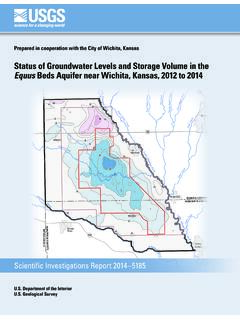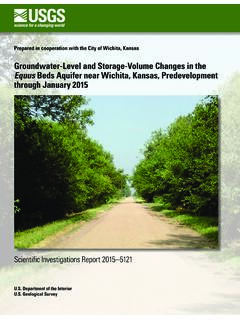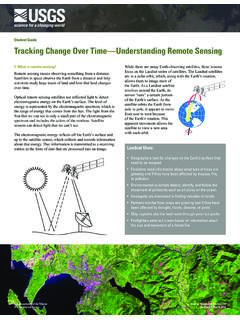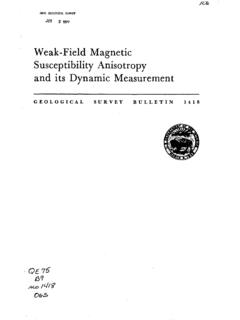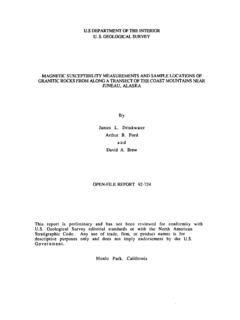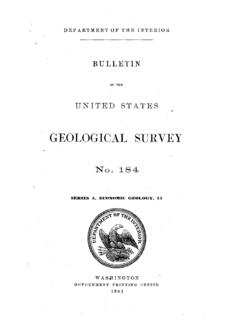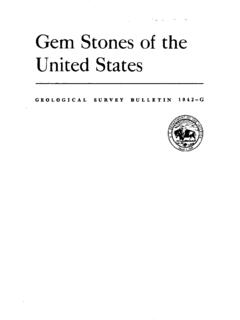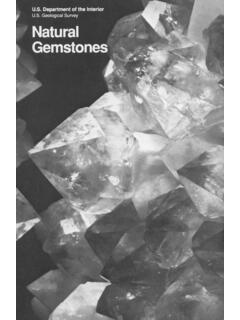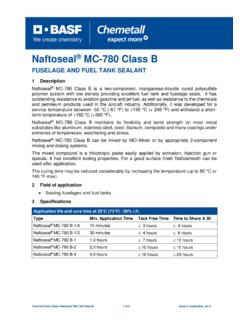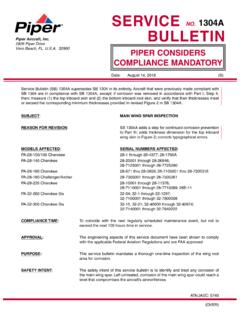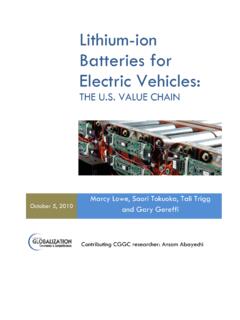Transcription of Lithium - USGS
1 LithiumChapter K ofCritical Mineral Resources of the United States Economic and Environmental Geology and Prospects for Future SupplyProfessional Paper 1802 Department of the Geological SurveyPeriodic Table of Elements8A1A2A3B4B5B6B7B8B11B12B3A4A5A6A 7 Aelement names in blue are liquids at room temperatureelement names in red are gases at room temperatureelement names in black are solids at room temperature1113 41219 20 21 22 23 24 25 26 27 28 29 3037 38 39 40 41 42 43 44 45 46 47 4855 5658 59 6072 73 74 75 76 77 78 79 8087 8890578991 92 93 94 95 96104 105 106 107 108 109110 111 11261 62 63 64 65 66 6797 98 9968 69 70 71100 101 102 1033113 14 15 16 17 1832 33 34 35 3649 50 51 52 53 5481 82 83 84 85 865 6 7 8 9 (98) (209)(210)(222) (223)(226)(265)(268)(271)(270)(277)(276) (281)(280)(285) (145) (227)231238(237)(244)(243)(247)(247)(251 )(252)(257)(258)(259)(262) (289)(288)(284)(293)(294)(294)
2 Hydrogenbariumfranciumradiumstrontiumsod iumvanadiumberylliumlithiummagnesiumpota ssiumcalciumrubidiumcesiumheliumboroncar bonnitrogenoxygenfluorineneonaluminumsil iconphosphorussulfurchlorineargonscandiu mtitaniumchromiummanganeseironcobaltnick elcopperzincgalliumgermaniumarsenicselen iumbrominekryptonyttriumzirconiumniobium molybdenumtechnetiumrutheniumrhodiumpall adiumsilvercadmiumindiumtinantimonytellu rium iodinexenonhafniumceriumpraseodymiumneod ymiumpromethiumsamariumeuropium gadoliniumterbium dysprosiumholmiumerbiumthuliumytterbiuml utetiumtantalumtungstenrheniumosmiumirid iumplatinumgoldmercurythalliumleadbismut hpoloniumastatineradonthoriumlanthanumac tiniumprotactinium uraniumneptuniumplutoniumamericiumcurium berkeliumcaliforniumeinsteiniumfermiumme ndeleviumnobeliumlawrencium rutherfordiumdubniumseaborgiumbohriumhas siummeitneriumdarmstadtiumroentgeniumcop erniciumfleroviumlivermoriumLanthanide Series*Actinide Series**Modified from Los Alamos National Laboratory Chemistry Division; available at Lithium -brine evaporating ponds at Clayton Valley, Nevada.
3 The dark rectangular pond at the upper center of the image is kilometers long. Photograph by Doc ( ).LithiumBy Dwight C. Bradley, Lisa L. Stillings, Brian W. Jaskula, LeeAnn Munk, and Andrew D. McCauleyChapter K ofCritical Mineral Resources of the United States Economic and Environmental Geology and Prospects for Future SupplyEdited by Klaus J. Schulz, John H. DeYoung, Jr., Robert R. Seal II, and Dwight C. BradleyProfessional Paper 1802 Department of the Geological Department of the InteriorRYAN K. ZINKE, Geological SurveyWilliam H. Werkheiser, Acting Geological Survey, Reston, Virginia: 2017 For more information on the USGS the Federal source for science about the Earth, its natural and living resources, natural hazards, and the environment visit or call 1 888 ASK an overview of USGS information products, including maps, imagery, and publications, visit use of trade, firm, or product names is for descriptive purposes only and does not imply endorsement by the this information product, for the most part, is in the public domain, it also may contain copyrighted materials as noted in the text.
4 Permission to reproduce copyrighted items must be secured from the copyright citation:Bradley, , Stillings, , Jaskula, , Munk, LeeAnn, and McCauley, , 2017, Lithium , chap. K of Schulz, , DeYoung, , Jr., Seal, , II, and Bradley, , eds., Critical mineral resources of the United States Economic and environmental geology and prospects for future supply: Geological Survey Professional Paper 1802, p. K1 K21, 2330-7102 (online)iiiContentsAbstract .. Overview ..K1 Lithium as a Critical Element ..K2 Uses and Sources ..K2 Geology ..K5 Geochemistry and Mineralogy ..K5 Deposit Types ..K5 Lithium -Cesium-Tantalum Pegmatite Deposits ..K8 Lithium -Enriched Granites ..K8 Lithium Brine Deposits in Closed Basins ..K8 Lithium in Other Brines ..K12 Lithium -Clay Deposits ..K12 Lithium -Zeolite Deposits ..K12 Resources and Production ..K13 Production ..K13 Reserves and Other Identified Resources ..K13 Undiscovered Resources ..K13 Exploration for New Deposits ..K14 Exploration for Lithium -Cesium-Tantalum Pegmatite Deposits.
5 K14 Exploration for Lithium -Brine Deposits in Closed Basins ..K14 Exploration for Lithium in Sedimentary Rocks (Clays and Zeolites) ..K14 Environmental Considerations ..K15 Sources and Fate in the Environment ..K15 Mine Waste Characteristics ..K16 Human Health Concerns ..K16 Ecological Health Concerns ..K16 Carbon and Future Research ..K17 Acknowledgments ..K17 References Graph showing world Lithium production from 1900 to 2007, by deposit type and year ..K1K2. Pie chart showing major end uses of Lithium as a percentage of world consumption in 2013 ..K2K3. Photographs showing some sources and uses of Lithium ..K3K4. World map showing locations of selected Lithium -cesium-tantalum pegmatites and Lithium granites ..K6K5. World map showing locations of selected closed-basin Lithium -brine, Lithium -enriched oilfield brine, geothermal brine, Lithium -clay, and Lithium -zeolite deposits ..K7K6. Histograms showing the broad correspondence in the age distributions of Lithium -cesium-tantalum pegmatites, detrital zircons from modern river sands, and Lithium resources in Schematic cross section showing the concentric arrangement of Lithium -cesium-tantalum pegmatites around a parental granite pluton.
6 K10K8. Conceptual ore-deposit model for Lithium brine ..K11K9. Plots of Lithium grade and tonnage for selected world deposits ..K13 TablesK1. Commercially and (or) scientifically important Lithium -bearing minerals ..K5K2. Lithium concentrations in soils developed on various types of FactorsInternational System of Units to Inch/PoundMultiplyByTo obtainLengthangstrom ( ) ( nanometer) ( ) ( nanometer) ( m) [or micron] (mm) (in.)centimeter (cm) (in.)meter (m) (ft) meter (m) (yd) kilometer (km) (mi)Areahectare (ha) kilometer (km2) meter (m2) foot (ft2) square centimeter (cm2) inch (ft2) square kilometer (km2) mile (mi2)Volumemilliliter (mL) , fluid (fl. oz)liter (L) , fluid (fl. oz)liter (L) (qt)liter (L) (gal)cubic meter (m3) (gal) cubic centimeter (cm3) inch (in3) cubic meter (m3) yard (yd3) cubic kilometer (km3) mile (mi3) Massmicrogram ( g) , avoirdupois (oz)milligram (mg) , avoirdupois (oz)gram (g) , avoirdupois (oz)gram (g) , troykilogram (kg) , troykilogram (kg) avoirdupois (lb)ton, metric (t) , short [2,000 lb]ton, metric (t) , long [2,240 lb]Deposit gradegram per metric ton (g/t) per short ton (2,000 lb) (oz/T)Pressuremegapascal (MPa)10bargigapascal (GPa)10,000barDensitygram per cubic centimeter (g/cm3) per cubic foot (lb/ft3) milligram per cubic meter (mg/m3) per cubic foot (lb/ft3)Energyjoule (J) (kWh)joule (J) 1018electronvolt (eV)joule (J) (cal)kilojoule (kJ) (kcal)viInternational System of Units to Inch/Pound ContinuedMultiplyByTo obtainRadioactivitybecquerel (Bq) ( Ci)kilobecquerel (kBq) ( Ci)Electrical resistivityohm meter ( -m) inch ( -in.)
7 Ohm-centimeter ( -cm) inch ( -in.)Thermal conductivitywatt per centimeter per degree Celsius (watt/cm C) British thermal unit inch per hour per square foot per degree Fahrenheit (Btu in/h ft2 F)watt per meter kelvin (W/m-K) British thermal unit inch per hour per square foot per degree Fahrenheit (Btu in/h ft2 F)Inch/Pound to International System of ( m) [or micron]inch (in.) (cm)inch (in.) (mm)foot (ft) (m)mile (mi) (km)Volumeounce, fluid (fl. oz) (mL)ounce, fluid (fl. oz) (L) Massounce, avoirdupois (oz)28,350,000microgramounce, avoirdupois (oz)28,350milligramounce, avoirdupois (oz) (g) ounce, 348gram (g)ounce, (kg)pound, avoirdupois (lb) (kg) ton, short (2,000 lb) , metric (t) ton, long (2,240 lb) , metric (t) Deposit gradeounce per short ton (2,000 lb) (oz/T) per metric ton (g/t)Energykilowatthour (kWh)3,600,000joule (J)electronvolt (eV) 10 19joule (J)Radioactivitymicrocurie ( Ci)37,000becquerel (Bq)microcurie ( Ci)37kilobecquerel (kBq)Temperature in degrees Celsius ( C) may be converted to degrees Fahrenheit ( F) as follows: F = ( C) + 32 Temperature in degrees Celsius ( C) may be converted to kelvin (K) as follows: K = C + in degrees Fahrenheit ( F) may be converted to degrees Celsius ( C) as follows: C = ( F 32) / otherwise stated, vertical and horizontal coordinate information is referenced to the World Geodetic System of 1984 (WGS 84).
8 Altitude, as used in this report, refers to distance above the vertical InformationSpecific conductance is given in microsiemens per centimeter at 25 degrees Celsius ( S/cm at 25 C).Concentrations of chemical constituents in soils and (or) sediment are given in milligrams per kilogram (mg/kg), parts per million (ppm), or parts per billion (ppb).Concentrations of chemical constituents in water are given in milligrams per liter (mg/L), micrograms per liter ( g/L), nanogams per liter (ng/L), nanomoles per kilogram (nmol/kg), parts per million (ppm), parts per billion (ppb), or parts per trillion (ppt).Concentrations of suspended particulates in water are given in micrograms per gram ( g/g), milligrams per kilogram (mg/kg), or femtograms per gram (fg/g).Concentrations of chemicals in air are given in units of the mass of the chemical (milligrams, micrograms, nanograms, or picograms) per volume of air (cubic meter).Activities for radioactive constituents in air are given in microcuries per milliliter ( Ci/mL).
9 Deposit grades are commonly given in percent, grams per metric ton (g/t) which is equivalent to parts per million (ppm) or troy ounces per short ton (oz/T).Geologic ages are expressed in mega-annum (Ma, million years before present, or 10 6 years ago) or giga-annum (Ga, billion years before present, or 10 9 years ago).For ranges of years, to and (or) the en dash ( ) mean up to and including. Concentration unitEqualsmilligram per kilogram (mg/kg)part per millionmicrogram per gram ( g/g)part per millionmicrogram per kilogram ( g/kg)part per billion (109)Equivalenciespart per million (ppm): 1 ppm = 1,000 ppb = 1,000,000 ppt = percentpart per billion (ppb): ppm = 1 ppb = 1,000 ppt = percentpart per trillion (ppt): ppm = ppb = 1 ppt = percentMetric system prefixestera- (T-)10121 trilliongiga- (G-)1091 billionmega- (M-)1061 millionkilo- (k-)1031 thousandhecto- (h-)1021 hundreddeka- (da-)101 tendeci- (d-)10 11 tenthcenti- (c-)10 21 hundredthmilli- (m-)10 31 thousandthmicro- ( -)10 61 millionthnano- (n-)10 91 billionthpico- (p-)10 121 trillionthfemto- (f-)10 151 quadrillionthatto- (a-)10 181 quintillionthviiiAbbreviations and Symbols C degree Celsiusg gramHMIS Hazardous Materials Identification SystemISMI International Strategic Minerals Inventorykg kilogramkm kilometerkm2 square kilometerLC50 lethal concentration 50 (concentration that kills 50 percent of test population within a given timeframe)
10 LCT Lithium -cesium-tantalumm meterMa mega-annummg milligrammg/d milligram per daymg/kg milligram per kilogrammg/L milligram per literNFPA National Fire Protection Associationppm part per millionUSGS Geological SurveyLithiumBy Dwight C. Bradley, Lisa L. Stillings, Brian W. Jaskula, LeeAnn Munk, and Andrew D. McCauleyAbstractLithium, the lightest of all metals, is used in air treatment, batteries, ceramics, glass, metallurgy, pharmaceuticals, and polymers. Rechargeable Lithium -ion batteries are particularly important in efforts to reduce global warming because they make it possible to power cars and trucks from renewable sources of energy (for example, hydroelectric, solar, or wind) instead of by burning fossil fuels. Today, Lithium is extracted from brines that are pumped from beneath arid sedimentary basins and extracted from granitic pegmatite ores. The leading producer of Lithium from brine is Chile, and the leading producer of Lithium from pegmatites is Australia.
